
St. Andrews Square [lower-alpha 1] is a mainly 1876 to 1884-built garden square in Surbiton in the borough of Kingston upon Thames, [lower-alpha 2] London.

St. Andrews Square [lower-alpha 1] is a mainly 1876 to 1884-built garden square in Surbiton in the borough of Kingston upon Thames, [lower-alpha 2] London.
The houses enclose a zone of 400 feet (120 m) by 240 feet (73 m), so 96,000 square feet (8,900 m2). A railed park takes up a little over half of this space, and the flanking, capillary, streets and pavements are broad.
The eponymous street lines three sides, but not the east (St. James Road). In the north-west corner it has a short continuation fronting 2+1⁄2 houses. Numbering, where used, is consecutive; to north: No.s 1 to 15 and to south: No.s 30, 30A, 31 to 40. Facing the west side, Little Dell and Little Rex are houses enjoying a garden greater than footprint, the other, Rex House matches the rest of the homes (ratio of the two land uses including much hardstanding to front yards (not part of the original scheme) is near 1:1). Eight apartments occupy the former houses No.s 28 and 29. Some of the houses have been internally split into flats.
Mature, oldest trees and all buildings' façades (their outer design and materials) are strictly protected by being in the conservation area.
The borough have made this and parts of two adjoining streets a Conservation Area:
It is an "area of Victorian housing dating from the 1860s – 1880s, in Gothic and Classical styles, including a garden square unique to South West London. It forms a later phase of the Surbiton “New Town” begun in 1838 by Thomas Pooley." [1]
It "is one of the few remaining Victorian squares in SW London and is the only example of traditional Victorian square development in the borough. Three sides of the square are lined with closely-knit three-storey brick Victorian terraced houses built between 1876–1884 by local developers Corbett and McClymont in the Gothic style. In addition to these...[included is] St Andrews Church, the central garden of the Square and the interesting group of Victorian houses on Maple Road in the Classical style. [1]
Apart from six mid-19th-century stuccoed houses on the north side of St. James Road (№s. 72-82), and three mid 19th century houses at Nos 61 - 65 Maple Road, all of the houses [herein] were built at the same time and by the same developers, Corbett and McClymont." [1]
The west end of St Andrew's Church, Surbiton faces a point of the eastern side's road (Maple Road) just north of the north-west corner of the square. It is a Grade II listed building (statutorily protected and recognised in the mainstream, initial category of the scheme).
In the local planning scheme, a lesser protection of Locally Listed Building applies to: 1–15 and 32–40 St. Andrews Square and facing or nearby in the Conservation Area: 14–42, 46–60, 61–65 and 17–25 Maple Road; and 17–25 St. James Road. [1]
Citations;

The West End of London is a district of Central London, west of the City of London and north of the River Thames, in which many of the city's major tourist attractions, shops, businesses, government buildings and entertainment venues, including West End theatres, are concentrated.

Carshalton is a town, with a historic village centre, in south London, England, within the London Borough of Sutton. It is situated 9.5 miles (15.3 km) south-southwest of Charing Cross, in the valley of the River Wandle, one of the sources of which is Carshalton Ponds in the middle of the village. Prior to the creation of Greater London in 1965, Carshalton was in the administrative county of Surrey.

Russell Square is a large garden square in Bloomsbury, in the London Borough of Camden, built predominantly by the firm of James Burton. It is near the University of London's main buildings and the British Museum. Almost exactly square, to the north is Woburn Place and to the south-east is Southampton Row. Russell Square tube station sits to the north-east.

Pollokshields is an area in the Southside of Glasgow, Scotland. Its modern boundaries are largely man-made, being formed by the M77 motorway to the west and northwest with the open land of Pollok Country Park and the Dumbreck neighbourhood beyond, by the Inverclyde Line railway and other branches which separate its territory from the largely industrial areas of Kinning Park, Kingston and Port Eglinton, and by the Glasgow South Western Line running from the east to south, bordering Govanhill, Strathbungo, Crossmyloof and Shawlands residential areas. There is also a suburban railway running through the area.

De Beauvoir Town is a neighbourhood in east London and is in the London Borough of Hackney, 2 miles (3.2 km) north of the City of London. The area was a part of the Hackney; the Ancient Parish and subsequent Metropolitan Borough that was incorporated into the larger modern borough. It is sometimes described as a part of Dalston, which is in turn, also a part of the former parish and borough of Hackney.

Hook is a suburban area in south west London, England. It forms part of the Royal Borough of Kingston upon Thames and is located 12 miles (19.3 km) south west of Charing Cross. Neighbouring settlements include Hinchley Wood, Long Ditton, Surbiton, Tolworth and Chessington.

Squares have long been a feature of London and come in numerous identifiable forms. The landscaping spectrum of squares stretches from those with more hardscape, constituting town squares —to those with communal gardens, for which London is a major international exponent, known as garden squares.
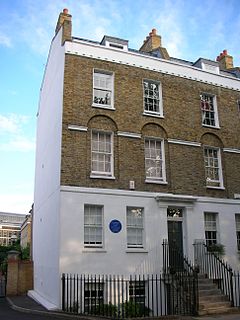
West Square is a historic square in south London, England, just south from St George's Road. The square is within the London Borough of Southwark, but as it is located in postcode SE11, it is commonly said to be in Lambeth.

Ravenscourt Park or RCP is an 8.3 hectares public park and garden located in the London Borough of Hammersmith and Fulham, England. It is one of the Borough's flagship parks, having won a Green Flag Award. Stamford Brook and Ravenscourt Park tube stations are close by.
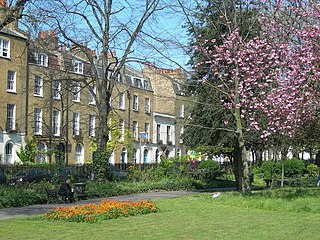
Clapton Square is the second largest garden square in the London Borough of Hackney, located in Lower Clapton, Clapton. It is lined by buildings on three sides. Its Conservation Area designated in 1969 – extended in 1991 and 2000 – takes in a larger green space separated by a stretch of open road: St John's Gardens. Those gardens have the tallest and largest building visible from all parts of the square's garden, the Church of St John-at-Hackney, rebuilt in 1792-97 which contains older monuments. Two sides of the square are lined with tall, partly stone-dressed, classical, Georgian terraced houses.
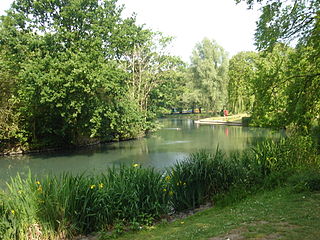
Pymmes Park is located in Edmonton, London and is bordered by the North Circular Road.

Arbour Square is a late Georgian square in Stepney, in the borough of Tower Hamlets, east London, England.
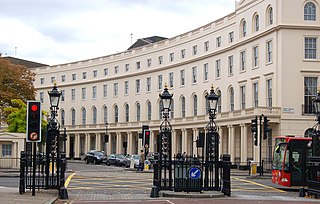
Park Crescent is at the north end of Portland Place and south of Marylebone Road in London. The crescent consists of elegant stuccoed terraced houses by the architect John Nash, which form a semicircle. The crescent is part of Nash's and wider town-planning visions of Roman-inspired imperial West End approaches to Regent's Park. It was originally conceived as a circus (circle) to be named Regent's Circus but instead Park Square was built to the north. The only buildings on the Regent's Park side of the square are small garden buildings, enabling higher floors of the Park Crescent buildings to have a longer, green northern view.
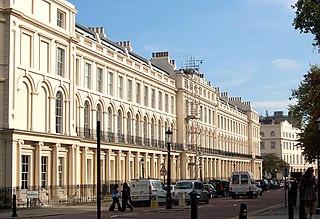
Park Square is a large garden square or private appendix to Regent's Park in London and is split from a further green, the long northern side of Park Crescent, by Marylebone Road and (single-entrance) Regent's Park tube station. It consists of two facing rows of large, very classically formed, stuccoed, terraced houses with decorative lower floor balconies and a colonade of consecutive porticos by architect John Nash, and was built in 1823–24. Alike, shorter-length terraces flank its corners at right angles, equally Grade I listed buildings: Ulster Terrace, Ulster Place, St Andrew's Place and Albany Terrace.

Surbiton Park is an area in the Royal Borough of Kingston upon Thames in Greater London, United Kingdom. It was the southernmost part of the pre-1965 Royal Borough of Kingston-upon-Thames in Surrey and corresponds roughly to the southernmost part of the present-day Kingston upon Thames postal district.

The Boathouse is a commercial property located at Ranelagh Drive, Twickenham in England, which housed music and film studios.

Adelaide Crescent is a mid-19th-century residential development in Hove, part of the English city and seaside resort of Brighton and Hove. Conceived as an ambitious attempt to rival the large, high-class Kemp Town estate east of Brighton, the crescent was not built to its original plan because time and money were insufficient. Nevertheless, together with its northerly neighbour Palmeira Square, it forms one of Hove's most important architectural set-pieces. Building work started in 1830 to the design of Decimus Burton. The adjacent land was originally occupied by "the world's largest conservatory", the Anthaeum; its collapse stopped construction of the crescent, which did not resume until the 1850s. The original design was modified and the crescent was eventually finished in the mid-1860s. Together with the Kemp Town and Brunswick Town estates, the crescent is one of the foremost pre-Victorian residential developments in the Brighton area: it has been claimed that "outside Bath, [they] have no superior in England". The buildings in the main part of Adelaide Crescent are Grade II* listed. Some of the associated buildings at the sea-facing south end are listed at the lower Grade II.
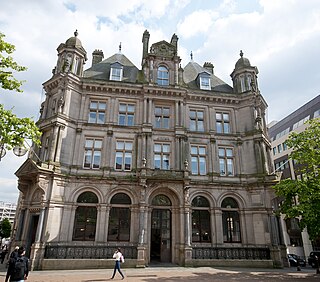
Victoria Square House, is an office building on the south side of Victoria Square, Birmingham, England. It was formerly Birmingham's Head Post Office, designed in the French Renaissance style by architect for the Office of Works Henry Tanner for the General Post Office.

King Square is a square in central London, in the St Luke's area of the London Borough of Islington. It is at the corner of Lever Street and Central Street, and shares in King Square Gardens to the west.

Hollywood Road is a residential street in the Brompton area, London, SW10. It runs roughly north to south from Tregunter Road to Fulham Road. The area is now located inside the Boltons Conservation Area, set up in 1970 by the Royal Borough of Kensington & Chelsea. Hollywood Road was put up early in the 1860s, before the more famous Hollywood in California was settled.